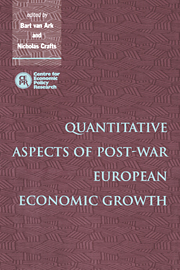Book contents
- Frontmatter
- Contents
- List of figures
- List of tables
- List of contributors
- Preface
- 1 Catch-up, convergence and the sources of post-war European growth: introduction and overview
- 2 Macroeconomic accounts for European countries
- 3 Sectoral growth accounting and structural change in post-war Europe
- 4 Measures of fixed capital stocks in the post-war period: a five-country study
- 5 Technology indicators and economic growth in the European area: some empirical evidence
- 6 Human capital and productivity in manufacturing during the twentieth century: Britain, Germany and the United States
- 7 Convergence and divergence in the European periphery: productivity in Eastern and Southern Europe in retrospect
- 8 Convergence: what the historical record shows
- 9 Growth and convergence in OECD countries: a closer look
- 10 On the historical continuity of the process of economic growth
- 11 Europe's Golden Age: an econometric investigation of changing trend rates of growth
- Index
4 - Measures of fixed capital stocks in the post-war period: a five-country study
Published online by Cambridge University Press: 23 December 2009
- Frontmatter
- Contents
- List of figures
- List of tables
- List of contributors
- Preface
- 1 Catch-up, convergence and the sources of post-war European growth: introduction and overview
- 2 Macroeconomic accounts for European countries
- 3 Sectoral growth accounting and structural change in post-war Europe
- 4 Measures of fixed capital stocks in the post-war period: a five-country study
- 5 Technology indicators and economic growth in the European area: some empirical evidence
- 6 Human capital and productivity in manufacturing during the twentieth century: Britain, Germany and the United States
- 7 Convergence and divergence in the European periphery: productivity in Eastern and Southern Europe in retrospect
- 8 Convergence: what the historical record shows
- 9 Growth and convergence in OECD countries: a closer look
- 10 On the historical continuity of the process of economic growth
- 11 Europe's Golden Age: an econometric investigation of changing trend rates of growth
- Index
Summary
Introduction
Comparing the levels and growth rates of fixed capital stocks is an important input into explaining differences in labour productivity and ultimately in standards of living across countries. To do so requires estimates of fixed capital which are measured in a consistent way across countries. Statistical offices in most countries do use the same measurement technique, the perpetual inventory method (PIM), which estimates current capital stocks as the sum of past real investments in fixed capital which have survived up to the current period. However each country differs in the assumptions they employ to implement the PIM, in particular, those on the service lives of assets.
This chapter attempts to shed more light on the issues involved in comparing fixed capital stocks across countries focusing on the impact of differences in mean service lives and the form retirement distributions are assumed to take around the average service life. It also considers in some detail problems which arise from differences in methods used to calculate investment deflators. The paper then presents capital stock measures for three European countries, the UK, Germany, and France. It is helpful to contrast the capital experience of the European countries with that in the USA, the world productivity leader, and with Japan which has experienced a marked improvement in relative productivity in the postwar period. The chapter therefore also presents capital stock estimates for these two countries.
- Type
- Chapter
- Information
- Quantitative Aspects of Post-War European Economic Growth , pp. 165 - 214Publisher: Cambridge University PressPrint publication year: 1997
- 2
- Cited by



